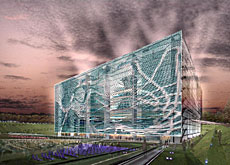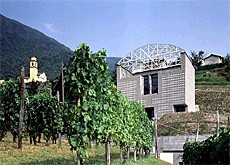Botta creations span the world

Mario Botta, Switzerland's most famous architect, is as busy as ever at age 60, accumulating prestigious projects all over the world.
swissinfo met up with Botta shortly after he returned from the Chinese capital, Beijing, where he is working on an art museum.
Born in Mendrisio, in canton Ticino, on April 1 1943, Botta has kept his youthful looks.
The architect has been extremely successful over the years. He met with Gemma d’Urso in Lugano – inside the cylindrical building he built alongside the Cassarate river – to talk about his career.
swissinfo: You have just come back from Beijing, where you signed a contract to build an art museum on the grounds of the Quinghua, the city’s most famous university…
Mario Botta: It’s my first Chinese project. In 2002, I went there to a conference, and the university asked me to take part in the competition to build a museum on the campus.
I won the competition and have, as you said, signed a contract.
The university is also opening a new arts school, which will be built by a team of American architects.
swissinfo: What was your impression of China?
M.B.: There is a sense of euphoria there at the moment, a sort of building frenzy, a need to develop projects, to adopt new architectural styles. If you look at Shanghai, for example, it’s a city that is literally mushrooming…
China has the resources and the impetus to pursue this kind of development. But the Chinese are facing a dilemma. They fear that their past might be buried under all the speedy changes they are undergoing.
swissinfo: You also visited Shanghai for the launch of the first Chinese-language book about your career. How was the book received?
M.B.: It is a superb book that follows my career, accompanied by a selection of photos. It was presented to a select few and people seemed to be very interested.
swissinfo: You have won many prestigious contracts all around the world in the past few years. What about your work in Switzerland?
M.B.: It’s true to say that my workload abroad is taking up most of my time.
I’m working a lot in Italy. The renovation of Milan’s Scala theatre should be finished by the end of 2004. The Pietrelcina congress centre project is also moving along.
On the other hand, my project to renovate the old port of Trieste has been suspended, and could even be blocked.
I have also drawn up plans for two churches, one in Seriate near Bergamo where building has begun, and another that will go up in Torino.
In Tuscany, I’m also going to build a wine cellar for a specialist who is about to launch a new kind of wine.
I am also preparing an exhibition in Padua, where I will present all my work from the past ten years, including designer objects and furniture.
Finally, I’m working on a museum project in Charlotteville, North Carolina.
In Switzerland, the construction of a parking lot along the lake in Morcote, in canton Ticino, has been slowed down by opposition from ecologists. A building permit has been requested all the same though.
The mountaintop restaurant in Les Diablerets, in canton Vaud, was on the other hand finished at the end of last year.
swissinfo: At a certain time in your life, you committed yourself to social justice, in particular helping asylum seekers. Do you still have time for this kind of activity?
M.B.: I don’t have as much time nowadays, but I try to be useful socially. Human beings are more important than architecture. I do what I can when I have the time.
swissinfo: Do you still think it is important for people to live in the historical city centres, because, as you said, “man has to be connected to history, the memories of a place”?
M.B.: More than ever. As time goes on, I am more and more convinced that an architect works in a historical context. You exist because you remember.
swissinfo: After a long and successful career, have you kept your original enthusiasm and the urge to create?
M.B. As the years go by, that urge has become even stronger. I can’t relax and slow down.
For each new project, I’m like a child. Every time I start something new it feels like the first time.
swissinfo-interview: Gemma d’Urso in Lugano (translation: Scott Capper)
Mario Botta was born in Mendrisio, in canton Ticino, in 1943.
Botta trained as a technical draftsman before he studied at the Liceo Artistico in Milan.
From 1965 to 1969, he studied at the Istituto Universitario di Architecttura in Venice.
During this same period he worked as an assistant to the Swiss architect, Le Corbusier and, then, to American Louis I. Kahn.
He opened his own practice in Lugano, Switzerland in 1970.
Botta built exclusively in Switzerland during his early career, gaining acclaim for such buildings as the Capuchin convent in Lugano, the craft centre in Balerna and the administration building for the state bank in Fribourg.
His other creations include San Francisco’s Museum of Modern Art, and the cathedral in Evry, France.

In compliance with the JTI standards
More: SWI swissinfo.ch certified by the Journalism Trust Initiative











You can find an overview of ongoing debates with our journalists here . Please join us!
If you want to start a conversation about a topic raised in this article or want to report factual errors, email us at english@swissinfo.ch.